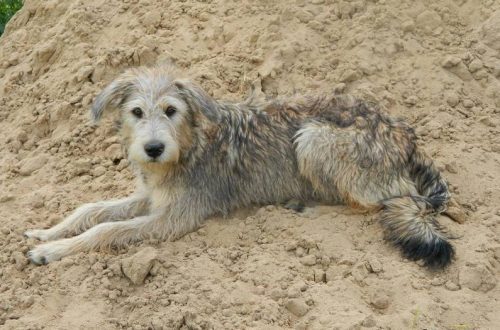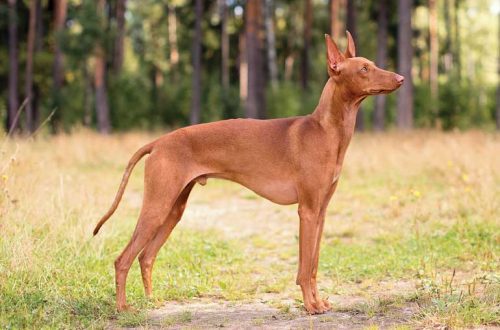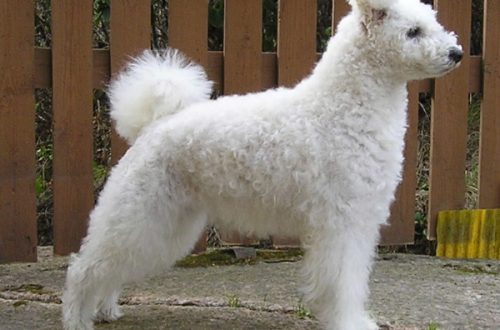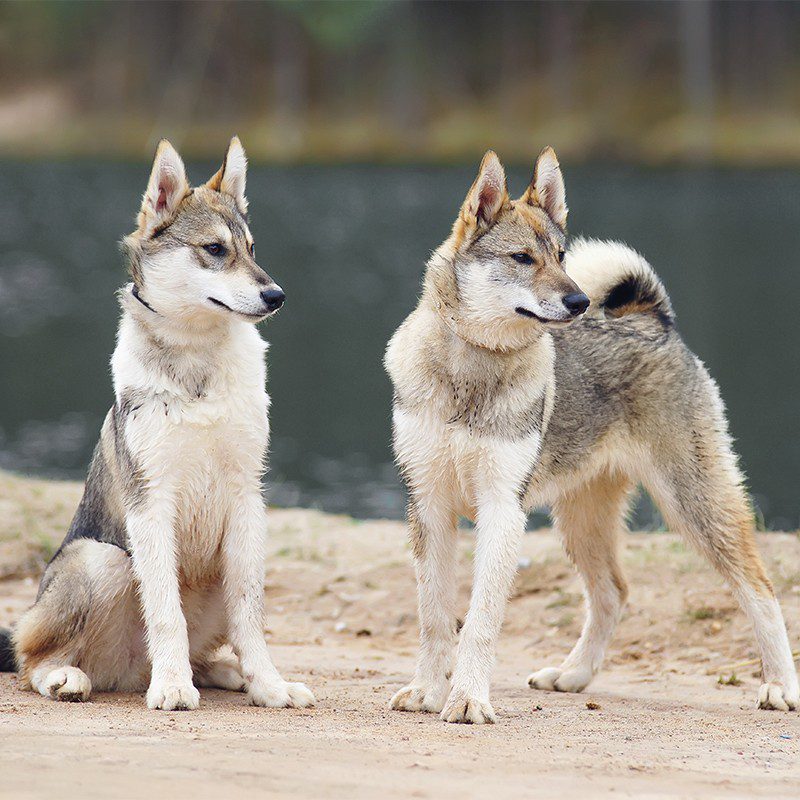
West Siberian Laika
Other names: ZSL
The West Siberian Laika is the most numerous variety of Laika, descended from taiga hunting dogs that have lived in the West Siberian Plain since ancient times.
Contents
- Characteristics of West Siberian Laika
- Basic moments
- History of the breed
- Video: West Siberian Laika
- West Siberian Laika breed standard
- The nature of the West Siberian Laika
- Education and training
- Hunting with West Siberian Laika
- Maintenance and care
- Hygiene
- Walking and training
- Feeding
- Health of the West Siberian Laika
- How to choose a puppy
- The price of the West Siberian Laika
Characteristics of West Siberian Laika
| Country of origin | USSR |
| The size | large |
| Growth | 55-62 cm |
| Weight | 18–23 kg |
| Age | 10–14 years old |
| FCI breed group | spitz and primitive breeds |
Basic moments
- The West Siberian Laika is a sociable dog, dependent on human attention and not getting used to loneliness. At the same time, in the wild and on walks, she demonstrates great independence, bordering on uncontrollability.
- ZSL is able to get along with other pets if she had to share the territory with them since childhood, but it is better not to count on true friendship between pets. Stray cats, urban pigeons and stray dogs are usually not treated with the goodwill of the husky.
- Despite the outstanding hunting qualities, the West Siberian Laika is considered less reckless than its relatives in the section. At the same time, this fact does not affect the yield of the breed.
- A bored dog is quite destructive, so an unattended animal can cause serious damage to a home. In addition, having nothing to do, ZSLs often entertain themselves and those around them with loud “concerts”.
- The aggression of the West Siberian Laika applies only to animals and never to humans, so it will not work to train an evil watchman or a suspicious guard from a representative of this breed.
- In terms of catching game, ZSL are absolutely universal, therefore they are equally successfully trained both on a bird and on large animals like a bear or a wild boar.
- The breed is unpretentious in everyday life. Its representatives do not require special care, they are perfectly adapted to harsh weather conditions and do not have strong food addictions, which allows animals to easily put up with forced “hunger strikes”.
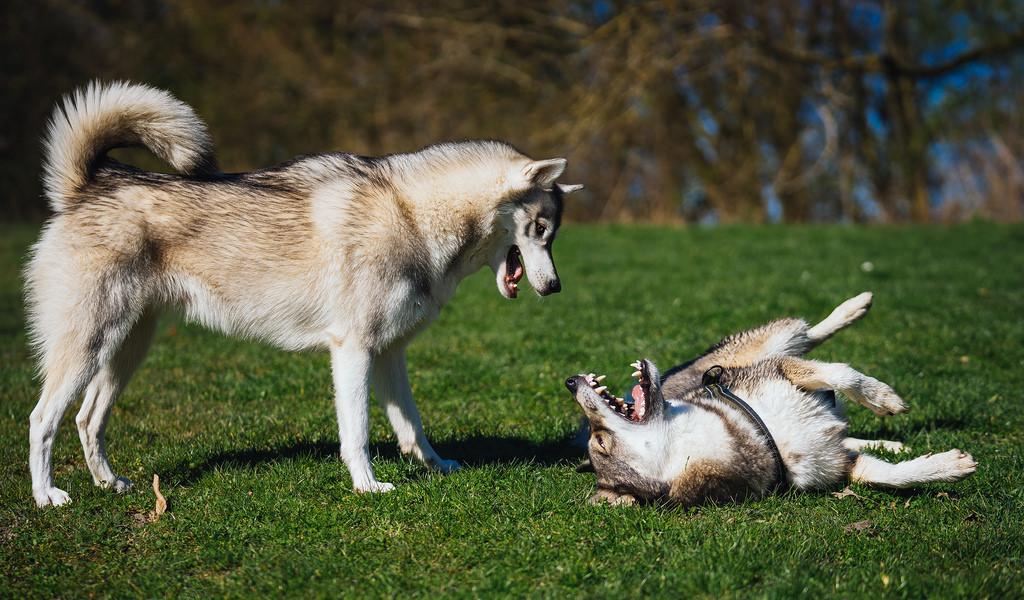
The West Siberian Laika is the hunter’s best friend and assistant, working with any kind of game. Balanced, but not phlegmatic, independent, but not trying to dominate everything and everyone, the West Siberian Laikas have long been valued by hunters for their extraordinary resourcefulness and devotion to the owner. They add to the breed attractiveness and unpretentiousness in everyday life, as well as the ability of its representatives to restore lost strength almost on the go. Figuratively speaking, West Siberian huskies are tireless hunters of forest trophies who are sincerely glad to work hard and will not meticulously study the contents of their own bowl.
History of the breed
The West Siberian Laika is a descendant of aboriginal hunting dogs that have lived behind the Ural Range since time immemorial. It is worth noting that until the beginning of the XX century. in the taiga villages lived many offspring of huskies, each of which had its own distinctive features and loyal fans among local hunters. There was no talk of division into breeds and intrabreed types then, so animals freely crossed among themselves, giving a person the right to select the most successful “copies”. Nevertheless, even under such conditions, the stratification into leaders and outsiders was quite natural. Therefore, when in 1939 the question of the standardization of huskies came up, experts immediately turned their attention to the Mansi (Vogul) and Khanty (Ostyak) offspring, which had established themselves as excellent getters of the taiga animals. In the same 1939, a meeting of Soviet dog handlers was held,
The purposeful breeding of the ancestors of the West Siberian Laikas began in the 40s of the XX century. due to state necessity. The country waging war needed money, which could be obtained, among other things, from the sale of furs and meat. Well, Siberian hunters and their four-legged assistants had to get this valuable product. According to the official version, the mission to popularize the breed was entrusted to the Krasnaya Zvezda nursery, although in fact, breeding and a kind of PR of animals were also carried out in the breeding nurseries of the Novosibirsk, Sverdlovsk and Perm regions.
In 1947, the Soviet cynologist E. I. Shereshevsky proposed to classify domestic Laikas according to the geographical principle, according to which the Khanty and Mansi offspring were united into a common, West Siberian group. The proposal was not accepted for consideration immediately, but in 1952 the section of northern hunting dogs was nevertheless replenished with three new breeds – the West Siberian, Karelian-Finnish and Russian-European huskies. A sharp jump in the popularity of ZSL occurred in the 60-70s, after which foreign breeders and cynological associations became interested in animals. And in 1980, the breed was finally recognized by the FCI, which opened the way for her to international exhibitions and competitions.
An important point. Considering the West Siberian Laika as a pure descendant of the Mansi and Khanty hunting dogs is not entirely correct. The breed did not develop in isolation, so mixing other offspring blood into its phenotype was common. Experts are sure that today’s WSLs have inherited part of the gene pool of the Udmurt, Ural, Nenets, Evenk and Zyryansk (Komi) Laikas, as well as some breed traits of German Shepherds.
Video: West Siberian Laika
West Siberian Laika breed standard
The West Siberian Laika is a dog of strong, if somewhat dry build, hardy and incredibly fast when it comes to chasing prey. By the way, this is one of those breeds whose representatives were affected by sexual dimorphism, so ZSL males are much larger than females. It is possible to distinguish a purebred West Siberian Laika from a pack of mestizos by body proportions. In particular, the length of the body of thoroughbred individuals significantly exceeds their height at the withers. In proportion it looks like 103-107/100 in males and 104-108/100 in females. If we compare the height of the withers and the sacrum of the animal, then the first one will be a centimeter or two larger (in female dogs, the discrepancy is less or completely absent). Special requirements are also imposed on the front legs of the husky: their length should be equal to ½ of the height of the pet at the withers.
Although the West Siberian Laika has been a factory breed for almost 80 years, puppies periodically appear in its litters, reminiscent of the appearance of the Vogul-Ostyak ancestors. In this regard, cynologists distinguish two main intrabreed types of ZSL – Khanty and Mansi. Representatives of the first variety are relatively stocky, have a wide head in the shape of an equilateral triangle and a rich dog, giving the silhouette of the dog additional volume. Mansi Laikas are usually taller and poorer “dressed”, their skull is narrower, and their eyes are rounder and more expressive.
Head
The head of the West Siberian Laika is dry, elongated, of a triangular type. The skull is narrow (a feature most pronounced in bitches), with a flat or slightly rounded forehead. On the whole, the profile of the animal is not particularly prominent: the brows of the ZSL are not too prominent, and the stop line is smoothed. The muzzle of the dog is wedge-shaped, equal in length to the skull.
Jaws and teeth
The purebred West Siberian Husky has a complete set (42) of strong teeth and powerful jaws with a scissor bite.
Nose
Lobe of normal size, painted black. At the same time, for individuals with white hair, a lighter, brownish shade of the lobe is typical.
Eyes
The oblong, dark brown eyes of the dog have a somewhat oblique set. Another distinguishing feature is that the eyeballs of the ZSL are set deeper than, for example, other varieties of huskies.
Ears
The ears of the West Siberian Laika are erect, of a regular triangular shape.
Neck
The dog’s neck is elongated, well muscled, of a dry type.
Frame
The relief withers of the animal smoothly passes into a straight, wide back, ending with a massive and somewhat inclined croup. The thorax is deep and of good width. The abdomen is moderately tucked up.
limbs
The front legs of the West Siberian Laika are even, spaced at a fairly distant distance from each other (wide set). The shoulder blades are long, strongly laid back, the elbows are pressed to the body, with developed, “looking” back joints. The hind limbs of the dog are muscular, with long, strong thighs, strong knees and almost vertical metatarsus. The paws are oval in shape, while the hind legs are inferior in size to the front. ZSL fingers are arched, collected, but the middle finger is somewhat knocked out of the general row due to its greater length.
Tail
Rolled into a “steering wheel” and thrown on its side or in the lumbar region. When untwisted, the tail hangs down to the hocks.
Wool
The wool of the West Siberian husky is formed by moderately hard integumentary hair and a voluminous, insulating layer of undercoat. In the shoulder area, the dog grows thicker, as a result of which a rich collar frames the dog’s neck. The hair on the front of all four legs is relatively short, while there are soft “panties” on the thighs. Small tufts of bristly hair also grow between the fingers of the husky, performing a protective function.
Сolors
The coat of the animal is most often colored in red, piebald, gray red-brown and white tones. The following combinations are also acceptable: white with brown, gray, red, fawn spots, zoned-piebald, zoned-red.
Disqualifying defects of the breed
- Congenital bite defects.
- Aggression or excessive indecision.
- Jaw distortion.
- Excessive behavioral and physical abnormalities.
- The absence of four or more teeth / the presence of additional incisors.
- Hanging or semi-erect ears.
- Belmo (clouding of the cornea), as well as the color of the iris interspersed with an unacceptable shade standard.
- Tail that is too short or has an atypical shape (saber-shaped, straight, etc.).
- Short/not long enough coat.
- Albinism. Non-standard coat colors: blue, brindle, chocolate.
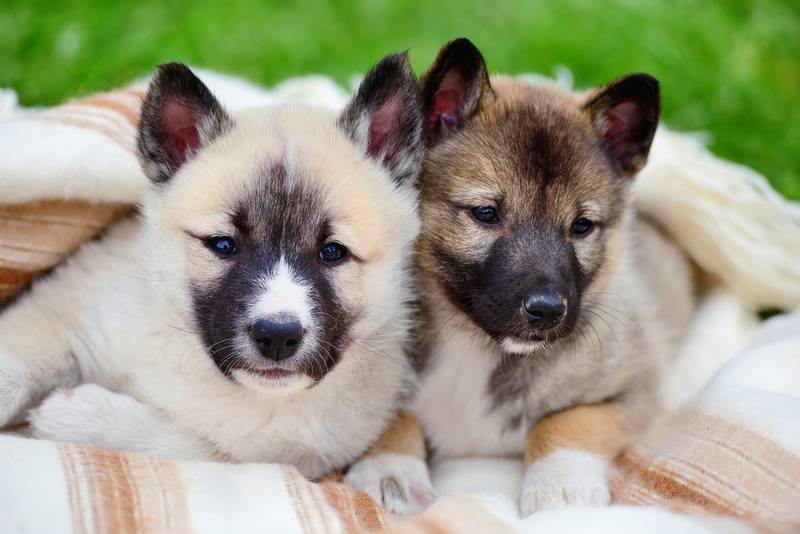
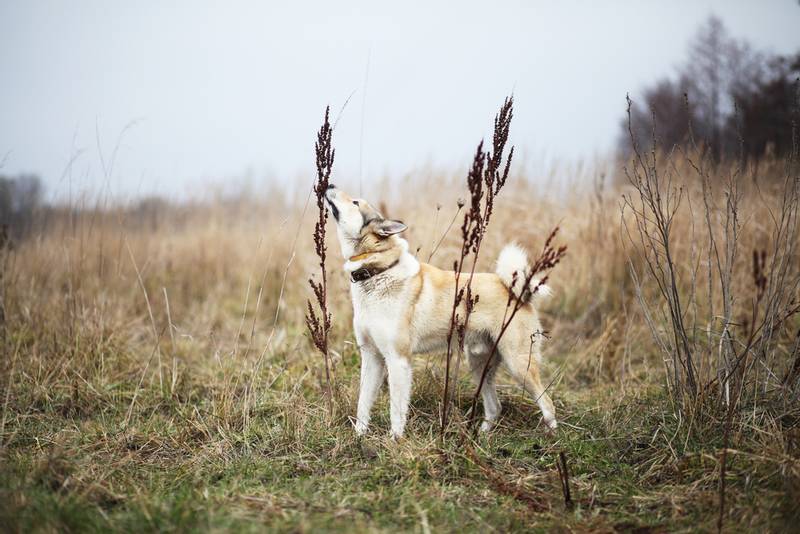
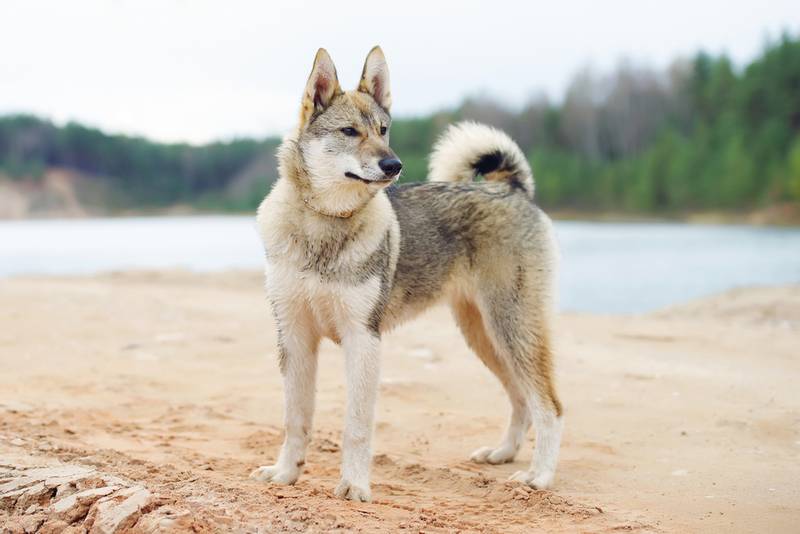
The nature of the West Siberian Laika
Likes are such… likes and the West Siberian is no exception here. Therefore, before acquiring such an active pet, it is better to ask yourself the question: do I have enough energy and patience so as not to turn the dog’s and my own existence into an eternal struggle for interests? Do not discount the “talkativeness” of the breed. Barking for ZSL is not another attempt to play on your nerves, but a means of communication, so do not count on the fact that you will hear a ringing “Woof!” pet only for hunting.
Mobility, innate playfulness and curiosity make the West Siberian Laikas wonderful hunters and sportsmen, but they are not the most outstanding companions. Accordingly, if you are not interested in seasonal trips for trophies as such, there is no point in contacting the breed. Driving animals for huskies is perhaps the main goal of its existence, and depriving an animal of this joy is simply cruel.
Any person for the West Siberian Laika is either a friend or a future friend, which, of course, affects the guard and watchdog qualities of the dog. On the one hand, the animal is not deprived of them and, with proper training, is able to drive away unwanted persons from housing. On the other hand, too ardent protection of the master’s property testifies to the instability of the psyche of a four-legged comrade, which is unacceptable in principle for a hunting breed.
West Siberian Laikas respect the laws of the pack and never compete with those who are weaker, so it is quite reasonable to leave them to look after children, to whom dogs are friendly and patronizing. It is believed that the APs are prone to the manifestation of independence and it is not worth limiting them in this. Nevertheless, representatives of this breed will not fight with a person for the right to be a leader for any price. The owner for the husky is a friend and mentor, with whom she sees no reason to compete, because working in pairs is much more interesting and correct.
The hunting instincts of representatives of the West Siberian Laika breed make themselves felt not only in the wild. In particular, NSLs are very intolerant of any animal they don’t know personally. Experienced dog lovers also know that keeping several ZSL males on the same territory is a pleasure for an amateur with a very restrained character, since dogs almost never stop competing with each other and finding out “who is the boss in the house”.
Education and training
The West Siberian Laika is not a circus dog, so do not waste time with it learning acrobatic tricks that are essentially useless for a hunting breed. It is also important to take into account the psychological characteristics of NSLs: slight stubbornness, self-will, loss of interest in learning – all this will certainly take place, albeit on a not the most outstanding scale. It is advisable to start raising and training a puppy from the age of 3 months using standard methods, that is, try not to overwork the baby, try to introduce him to new behaviors through play, etc. It’s good if you can take your pet to group classes. The pack and competitive instincts of the West Siberian Laika are very strong, so they always work more actively in a team. By the way, you can practice hunting skills with a dog only after
Pay special attention to prohibition commands. Excessive independence inherent in the breed should be easily corrected. If the dog does not respond to the ban, it is fraught with big troubles. In particular, it costs nothing for ZSL to escape during a walk, carried away by the pursuit of a gaping cat. Do not go to the other extreme and do not drill your pet. The West Siberian Laika is not a terry intellectual and a wearer of slippers, but a strong, merciless hunter, able to master the basic basics of etiquette just as much as is necessary in order to get along with a person and not create unnecessary problems for him.
Hunting with West Siberian Laika
In terms of hunting, the West Siberian Laika is a real all-rounder, capable of getting any game for its adored owner, from squirrels to bears. The dog’s upper and lower senses, which are equally well developed in representatives of this breed, innate viscosity (persistence in pursuing a goal and searching for a trace) and sonorous barking help the dog not lose the status of a super hunter. Another feature of the breed is the ability to work on the old track, which is considered aerobatics and is not given to all representatives of the section.
If you plan to raise a full-fledged earner from a pet, and not a useless “holder of a hunting diploma”, it is better to train an animal not on training grounds, but in natural conditions, where the animal is real, and not crazed from the endless barking of four-legged “students”, and the danger is real. By the way, it is absolutely not necessary to make “all-paws of the master” from the West Siberian Laika. No matter how wonderfully smart a dog is, it is not able to catch sable for you today, a wild boar tomorrow, and a bear a week later. Of course, there are exceptions, but this is already an innate gift, found only in the elite.
The degree of development of hunting instincts in West Siberian Laikas depends on how often the dog is in the wild. If you are used to taking your pet into the forest a couple of times a season, then do not expect him to demonstrate any superpowers. For the right husky, hunting should not be a holiday, but a natural change of location, where the animal must feel as confident as in its own enclosure. By the way, with training it is better not to delay. At 5-6 months, the puppy is already ready to periodically walk with the owner in the forest, practicing walking nearby and getting used to the surrounding smells and sounds. 10-month-old teenagers can begin to introduce the beast. It’s great if an adult hunting dog already lives in the house. In this case, the puppy will have someone to learn from. And be aware
Maintenance and care
West Siberian Laikas easily endure Russian frosts and are quite adapted to extreme weather conditions, so the best place to live for a working dog would be an aviary in the yard of a private house. In addition, for the comfortable existence of the ZSL, a lot of free space is required, so the option of settling a pet in an apartment is regarded as the worst possible one. It is also important to understand that, unlike their Russian-Finnish counterparts, West Siberian Laikas hardly get used to life in a metropolis, and indeed in any city. These restless “Siberians” prefer the countryside or at least the city outskirts.
List of things needed to keep a West Siberian Laika:
- insulated booth with bedding;
- bowls for food and drink;
- toys;
- leash for walking (from 2 m) and a collar;
- muzzle;
- tracker collar with GPS (for hunting enthusiasts).
It will not work to settle the West Siberian Laika in a booth or aviary and relax, since you will have to change the straw bedding for the animal weekly and clean up its waste products at least once a day. In addition, once a month it is recommended to make a complete disinfection of the enclosure.
Hygiene
The West Siberian Laika is an unpretentious working dog and it makes no sense to travel with it around the grooming salons. Yes, during the molting period (autumn-spring), the ZSL coat will have to be combed with a rare comb, sometimes connecting a furminator to the matter, but otherwise, not much time is spent on grooming and creating the image of a pet. Huskies are rarely washed: mostly before exhibitions or when the animal is thoroughly dirty. And in the summer there will be enough episodic swimming in open water.
The claws of working and well-walked dogs may not be cut at all. For individuals who are not among the most active, the plate is trimmed once a month with a nail cutter for large breeds. At the same time, it is better to inspect the eyes and ears of the inhabitants of the enclosures daily so as not to miss or start inflammation. One of the main working “tools” of the West Siberian Laika is paws, respectively, after hunting and walking, they should be given increased attention. Minor cuts, scratches, and other injuries should be treated immediately with veterinary ointments or creams. A good help will be vegetable oils, which are used to lubricate the paw pads in order to avoid the appearance of cracks and peeling on them.
Walking and training
The West Siberian Laika, which does not fully realize its energy potential, falls into depression, goes bald and often gains weight. Therefore, in order for the pet to be alert, healthy and live the entire period allotted to him, it is better to load him to the maximum. It is necessary to go out with the dog to get some air at least twice, and preferably three times a day, and the duration of the walk should be at least an hour. Be sure to include in these 60 minutes not only standard runs on a leash, but also elements of training, as well as active games. In order not to be outrageous at home, the West Siberian Laika must give all his best on the street, so ordinary festivities are indispensable here.
When taking your ward to a park, square or forest belt, do not lose vigilance. ZSL males are addicted natures and instantly disappear from sight if potential prey appears on the horizon. The best prevention for this behavior is a standard leash that allows you to control the movement of the animal. In general, once on the street, West Siberian Laikas demonstrate a terrible independence and almost do not pay attention to the owner, preferring to mind their own business. Sometimes it is difficult to “get through” to a dog, but it is necessary to do this, since it is overly self-confident and uncontrollable individuals who most often disappear on the hunt.
Feeding
To replenish the energy reserves spent on hunting and training, West Siberian Laikas prefer animal protein. Any lean meats are suitable here, from lamb to beef, and it is better if it is substandard – sinewy trimmings, winded pieces, etc. They give the meat raw or slightly scalded, but by no means boiled. Once a week, offal and fish (preferably the cod family) should appear in the dog’s bowl, while the size of the usual portion will have to be increased by a third.
Skimmed sour milk, whole grain cereals, thermally processed seasonal vegetables also diversify the ZSL menu. Vitamin supplements should not be neglected either, since few people manage to balance the diet with the help of exclusively natural products. Feeding the West Siberian Laika “drying” is regarded as a perfectly acceptable option, but in this case the desire to save money will have to be abandoned. Low-quality feed will not only not saturate the animal, but will also ruin its digestive and urinary systems.
Important: Before hunting, West Siberian Laikas are usually not fed.
Health of the West Siberian Laika
Centuries of natural selection and the harsh climate of the West Siberian Plain have polished the health of animals to a standard state. As a result, West Siberian Laikas have excellent immunity and practically no genetic diseases. The main enemy of the breed is forced physical inactivity, which provokes a lot of ailments, ranging from obesity to joint diseases. They pose a danger to the health of dogs and hunting trips. Huskies, carried away by the pursuit of the beast, can be injured by flying into trees, although they recover from such “accidents” surprisingly quickly. Often animals are bitten by snakes, ticks and small predators, so timely vaccination against rabies and treatment against ectoparasites will not be superfluous. In addition, NWFs can become infected with worms from caught and eaten game,
How to choose a puppy
- Males of the West Siberian Laika are more independent, prone to escaping, and also often sort things out in the pack. At the same time, the “boys” have pronounced pedigree features and look very colorful. “Girls” of the ZSL are less spectacular in appearance, but more accommodating and easier to learn. The only disadvantage of bitches is regular estrus, which interferes with hunting.
- When choosing a puppy for hunting, take an interest in the working achievements of his parents, or rather, look at one of them in action.
- Give preference to outwardly healthy, moderately well-fed babies who react to your arrival with curiosity and ringing barking.
- Don’t put too much trust in the old-fashioned “grandfather” methods of selecting the best puppy (checking on a log, squeezing the belly of a husky with your fingers, selecting by the color of the paw pads) that are so popular among hardened dog lovers. In 99% of cases, such “tests” do not give any guarantee that the individual you have chosen will be ideal.
- Check with the breeder what kind of litter the bitch has and when the previous one was. It is optimal if the dog gives birth no more than once a year. In addition, many cynologists believe that the first litter of West Siberian Laikas is not the most successful.
- Puppies can be tested for hearing and smell. In the first case, you need to wait until the kids fall asleep and snap your fingers over them. The puppy that reacts first to the noise will have the most outstanding hearing. The sense of smell is tested with food, setting a bowl of food at a distance and observing which of the puppies is the first to smell the appetizing smell.
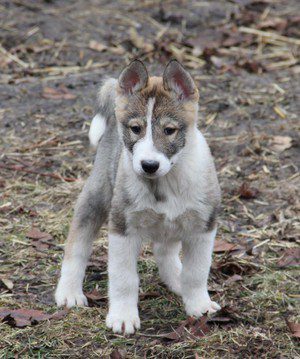
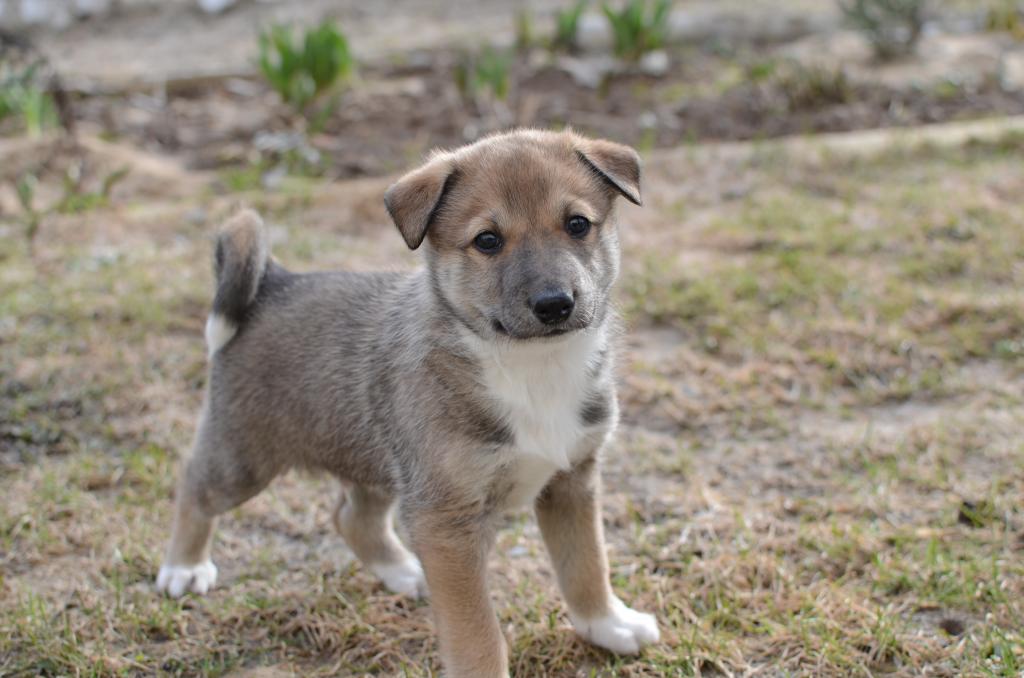
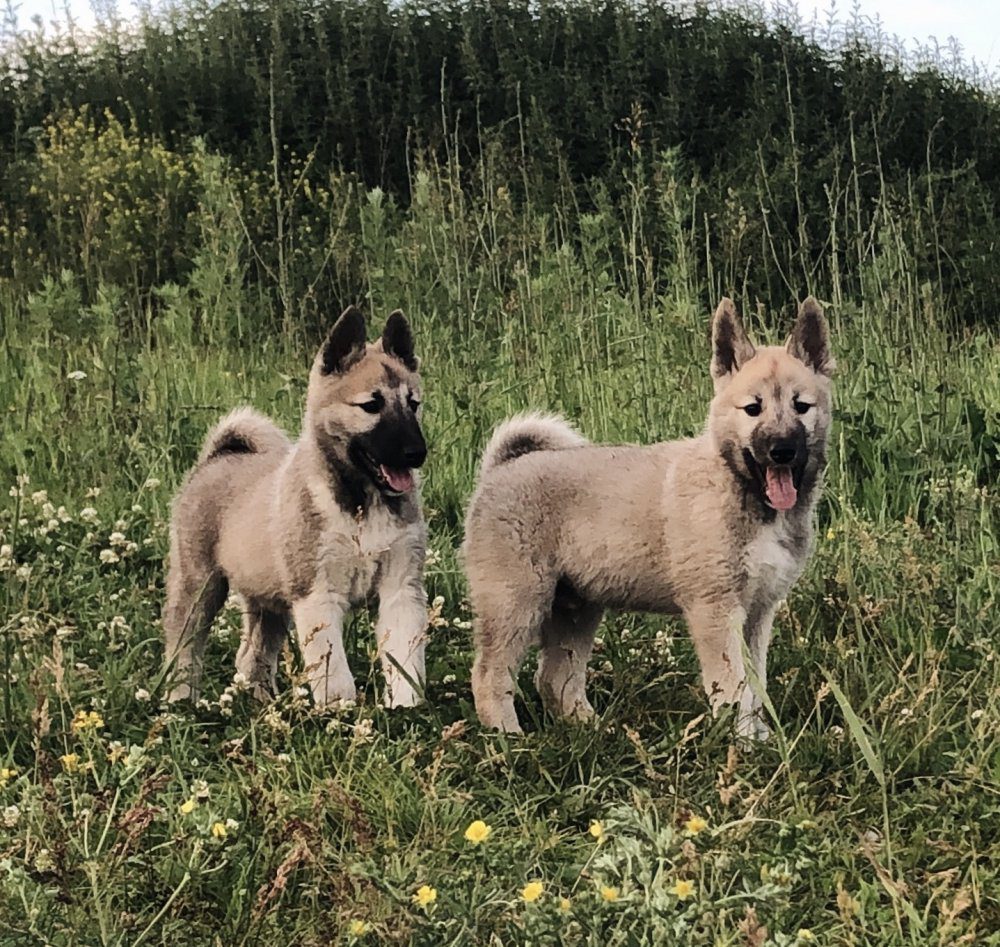
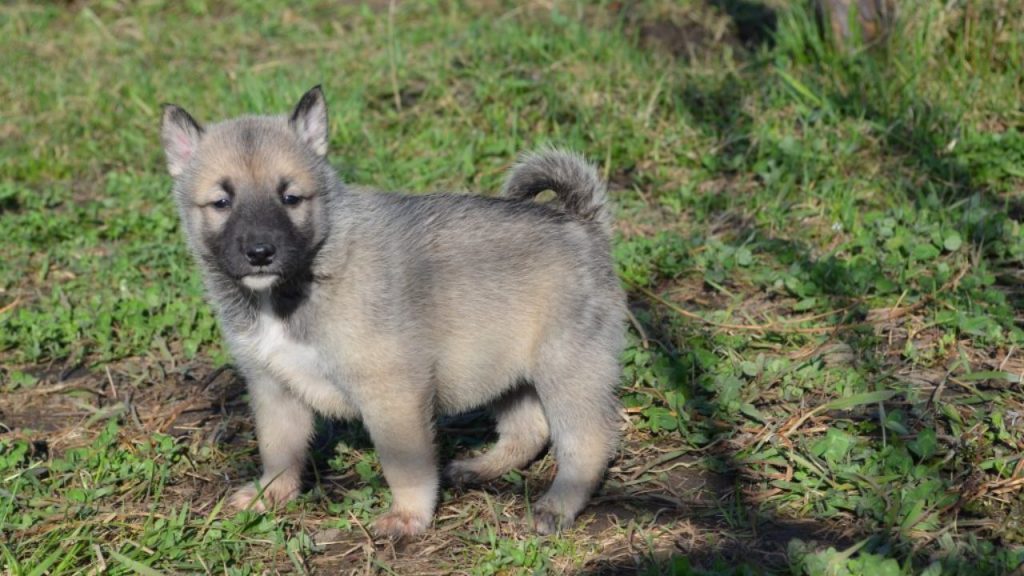
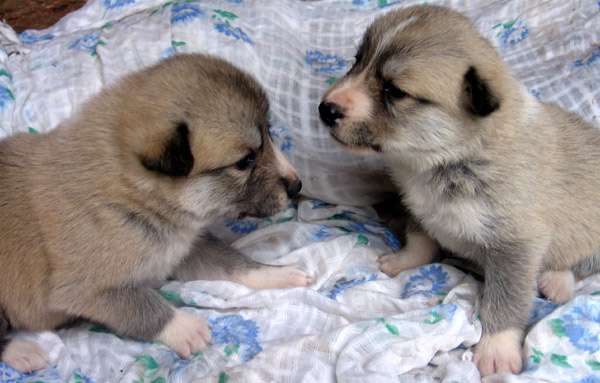
The price of the West Siberian Laika
The West Siberian Laika is not the most expensive breed. On average, a healthy, vaccinated puppy with documents will cost 15,000-20,000 rubles. If the exterior of the future pet is not so important, you can contact not a nursery, but a single breeder. Usually, professional hunters involved in breeding along the way rely on the working qualities of offspring, relegating the appearance of the dog to the background. Such puppies are much cheaper – from 200 to 300$.



